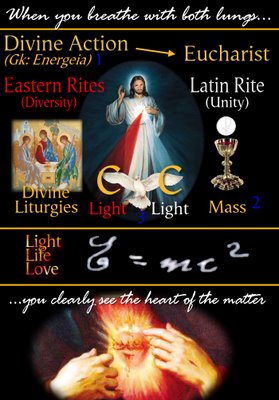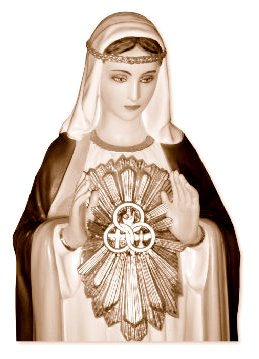The Great Escape...light speed and God Speed.
Hmmmmm? St. John, exiled on the Island of Patmos was pondering the things of God on the Lord's Day, right?
Well, this same Bill Long provides an interesting reflection on the Light as found in the Book of Revelation. http://www.drbilllong.com/Lectionary/Rev7II.html
Revelation 7:9-17 (II);
The Great Escape (II)
The "Meaning" of the Scene in 7:9-17
The first thing we observe is the mixing of verb tenses and the consequent unclarity regarding any time sequence in these chapters. Let me illustrate what I mean by trying to do a "linear" reading of Rev. 6 and 7. Take the martyrs in 6:9-11, who already are crying out for vindication. They have already died and are seemingly waiting around for something. But then, in ch. 7, we have a multitude of the saints preserved from destruction that happens on earth. They are described as those who have "come out of the great tribulation" (present tense) and who have "washed their robes..in the blood of the Lamb" (past tense). So, if we were thinking strictly linearly, we would have some problems here. Thus, do the saints all die in persecution? Are the numbers supposed to represent the "whole" or "complete number" of the saints? If so, when is John thinking about? An imminent persecution that will take all of these saints? If so, he was incorrect historically. An "end time" persecution? Well, this just fuels apocalyptic fervor which, in general, is not good for your health and usually is manipulated by people who just want to make a buck off of it. Thus, if we try to pursue the vision "historically" or "linearly" we run into all kinds of difficulties.
Another "Reading" of Rev. 6-7.
We need to treat the vision of chs 6 and 7, then, as imaginative literature, as literature that suggests pictures and gives scintillations in our mental vision like an Independence Day fireworks. The vision stands both inside and outside of time. Thus, temporal sequence must be left out of our field of vision as we let this dream/vision wash over us. Let me illustrate what I mean briefly by introducing a term to you that is fairly new in the history of science: tachyon. Ever since Albert Einstein amazed the 20th century in 1905 by positing his theory of special relativity, physicists, and science fiction writers, have been fascinated by the thought that there might be some particle in the universe that exceeds the speed of light. This particle, according to Einstein's theory, couldn't really exist because as it approaches the speed of light, it would have to assume an infinite mass (trust me on this one--as I trust the physicists).
But what Einstein's theory didn't cover, as I have read, is the possibility that there might be entities moving quicker than the speed of light not because they have "speeded up" to that pace but because, from the beginning, they can go that fast. These hypothetical entities have received the name of tachyons--from the Greek word tachys, meaning "speed" or "fast." Thus, if one was able to "catch a ride" on a tachyon, one might be able to go backwards in time, reliving earlier moments in one's life or in history. You can see how you could spend a whole afternoon in a daze just imagining what you would like to relive! (((As a young man Albert Einstein desired to find out what it would be like to ride a beam of light back to its source, "the Old One." Was he thinking about how angels move in eternity?)))
I think the concept of the tachyon helps us "understand" the glittering "time-outside of time" sequence of Rev. 6 and 7. We as it were are caught up on a tachyon and we see in the minds eye, with John, all of human history unfolding at once. Destruction, suffering, salvation, deliverance; all happen together and apart. The saints both experience them and are delivered from them; the chorus sings praise to God who destroys and delivers. We are thrown into a sort of whirlpool of images and we fully lose our sense of time, our bump of direction, our sense of whether we are "up" or "down." In other words, we are on a roller coaster of the spirit in these chapters, being taken upside down and sideways, thrown back and forth, carried on by some other force that we cannot understand but simply must yield to. The worst thing you can do in a roller-coaster ride is to stand up in the middle of it and bring it to a screeching halt as you "analyze" it. Let the total experience wash over you.
A Few Points/Pointers in Rev. 7:9-17
If you have this approach in mind, where the images flow together in kaleidoscopic fashion, you will be in the right frame of mind to feel your way through the text. But there are some observations that can be made about the language and flow of 7:9-17 which are "controllable," for those who want to feel as if are "on top of" the text.
1. The Greek text of 7:9 and the first words of 7:10 should be read slowly, for it helps to heighten the bold imagery of the whole. Here is the literal reading of the former: "After these things I looked, and behold, a great crowd, which to number it no one was able..." Then, in v. 10 there is the initial cry, "Salvation" (read "victory") to our God... The emphasis of the opening verse of the scene is the immensity of the multitude. It is more than a "sea" of faces that stand before the throne. Arithmetic (the Greek word for "numbering" is "arithmao") calculations fail. The experts in estimating crowds, who "fly over" the scene and do rapid calculations for the news media, would be floored by the multitude surrounding the throne. How can they all surround the throne but be so numerous? Are we to imagine rows and rows of people, a sort of "March on Washington" crowd? I don't think so--this is where our imagination must take over again, and imagine a sort of spatial constriction where the entire crowd has front-row seats.
They sing. They cry out with a loud voice. "Salvation" belongs to the one on the throne and to the Lamb. Caird, in his commentary The Revelation of St. John the Divine, suggests that John's Hebraic language (even though written in Greek, he is dependent on Hebrew-type expressions and he quotes the OT repeatedly) would include a "Hebraic" understanding of salvation. Rather than an abstract concept, salvation is really "victory." That fits the context nicely here. A victory of God is celebrated, in this case because of the victory through delivering the saints. Thus, the first point is the number and the cry. A shout of victory goes up.
2. Then we have the sevenfold amen in 7:12, which is the verse which Handel uses to conclude Messiah. Those who are learning Greek or who want to polish their Greek ought to take some time with this verse, for it "covers" the waterfront of Greek words for praise. We have eulogia (blessing), and doxa (glory--doxology), and sophia (wisdom; did you know that the word sophomore in English means 'wise-fool'--sometimes an apt description for a 19 year-old!), and eucharistia (thanksgiving--the Eucharist), and time (honor--a "timocratic" society is one based on honor), and dynamis (power--from which we get our English word "dynamite), and ischus (strength). If 12 is a perfect number in ancient Greek arithmology, then 7 is, too, and we have a "perfect" affirmation of praise in this verse. Rev. 4:11, an earlier hymn, has three words: doxa and time and dunamis; the other earlier hymn (Rev. 5:12) has dunamis and plouton (wealth, riches--a plutocracy is a rule by the rich) and sophia and ischus and time and doxa and eulogia. We enter into the heart of John's thinking by patiently working through his vocabulary.
3. The final message of ch. 7 is derived heavily from the OT, and is one of comfort and confidence. John especially draws upon the prophetic literature for his imagery. For example, listen to Is. 49 in the context of Rev. 7:"they shall not hunger or thirst,/ neither scroching wind nor sun shall strike them down,/ for he who has pity on then will lead them,/ and by springs of water will guide them" (49:10).
Other biblical passages cited are Is. 25:8; Jer.2:13; 31:16; Ps. 23:2; Ezek. 34:23). It is a veritable feast on biblical passages. The OT is cited because of the powerful comfort provided by the vivid imagery.
Conclusion
Let this be a day when the imagery of Revelation helps your spirit to soar. Let it be a day which helps you to break out of the limited and linear way of your thinking, as well. If you let it touch you deeply, a cascading series of pictures will take over your mind. And that is always good for preachers and preaching.
+ + +
Dr. Bill, though Presbyterian taps into a wellspring and as far as I can surmise, he doesn't contradict Catholic understanding of the Book of Revelation. He accepts the both/and of sacred scripture's prophecy of the endtimes. There even seems to be a note of anti-Rapturism. (The Rapture is a concept that we Catholics have never accepted for when it comes to the Kingdom, it is truly present in the here and now, even as it longs for future glory and the fulfillment of all things in Jesus Christ.)
As far as his use of the "imaginative", as long as he means to say images inspired by God, well then he is right on the mark.
A postscript from Dr. Bill:
"Proponents of 'Intelligent Design' are ignoring one powerful argument for their position: their own stupidity. Wouldn't it be just like God, the so-called 'intelligence' behind 'Intelligent Design,' to pick seemingly inadequate vessels to proclaim the truth of the theory? After all, what is St. Paul's central point of how God operates through people in I Cor 1?"
After reading more of his work online, there are many areas where he spouts vitriol anti-Catholicism. I hope that like Dr. Scott Hahn, another Gordon-Conwell alum, Bill Long eventually swims the Tiber to Rome Sweet Home.
Mike Rizzio, SOLT
Imitate Mary
Become like Jesus
Live for the Triune God
Seek the Light of Our Lord Jesus Christ
See you on the High Ground!
If you have a few minutes please go to the following sites
and see what I have been compelled to work on since 2004.
http://soltlaity.org/breadoflife.htm
http://soltlaity.org/slideshow.htm
I will attempt to answer any and all inquiries at jmjriz@aol.com.
+++
* - J.M.J. + O.B.T. + M.G.R. stands for: Jesus, Mary and Joseph;
O Beata Trinitas; St. Michael, St. Gabriel and St. Raphael































No comments:
Post a Comment